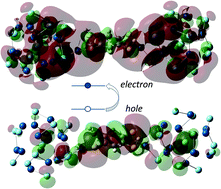Spectral shift, electronic coupling and exciton delocalization in nanocrystal dimers: insights from all-atom electronic structure computations†
Abstract
Delocalization of excitons promoted by electronic coupling between clusters or quantum dots (QD) changes the dynamical processes in nanostructured aggregates enhancing energy transport. A spectroscopic shift of the absorption spectrum upon QD aggregation is commonly observed and ascribed to quantum mechanical coupling between neighbouring dots but also to exciton delocalization over the sulphur-based ligand shell or to other mechanisms as a change in the dielectric constant of the surrounding medium. We address the question of electronic coupling and exciton delocalization in nanocrystal aggregates by performing all-atom electronic structure calculations in models of colloidal QD dimers. The relation between spectral shift, interdot coupling and exciton delocalization is investigated in atomistic detail in models of dimers formed by CdSe clusters kept together by bridging organic ligands. Our results support the possibility of obtaining exciton delocalization over the dimer and point out the crucial role of the bridging ligand in enhancing interdot electronic coupling.



 Please wait while we load your content...
Please wait while we load your content...